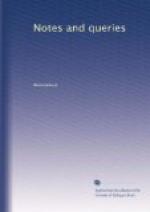The other cause assigned is, that the nine lozenges with which the saltire is charged in the armorial bearings of the Earl of Stair, are so arranged as to resemble the nine of diamonds, which was called the curse of Scotland, from the active part taken by that Earl in promoting the Union, which was most unpopular in Scotland. I cannot positively deny that the card in question owes its evil name to this cause, but I am not aware that the Earl of Stair was so conspicuously active as to occasion his being peculiarly selected as an object of popular aversion on that account. He was indeed a commissioner for drawing up the articles of the union, and he was sent ambassador to the court of Louis XIV. chiefly for the purpose of watching the proceedings of the Jacobites; these circumstances may have added to the odium which attached to his name from the part which was taken by his predecessor, who was Secretary for Scotland, and was charged with having exceeded his authority in ordering the massacre of Glencoe.
EDW. HAWKINS.
Nov. 12. 1849
[We would add to Mr. Hawkins’s Query, another, viz.: What is the earliest known instance of the card in question being so designated? For it is clear, if such was the case before the Union, the second explanation is as little satisfactory as the first.]
* * * * *
NOTES OF BOOK SALES—CATALOGUES, ETC.
The collectors of British portraits—and there are doubtless many such among our readers—will shortly have such an opportunity of enriching their portfolios as rarely presents itself. Messrs. Sotheby and Co. commence, on the 3rd of December, the sale of the second portion of the important and valuable stock of prints belonging to the well-known and eminent printsellers, Messrs. W. and G. Smith, whose shop in Lisle Street, Leicester Square, has been for so many years the favourite resort of all who were in search of the rare and curious in calcographic art. Messrs. Sotheby describe the present Sale as “comprising one of the most numerous and interesting collections of British Historical Portraits ever offered for sale;” and the following Lots, which exhibit specimens of the rarities it contains, justify their statement.
33 ARCHIBALD EARL OF ARGYLL, by Loggan, first state, before the inscription round the oval, VERY FINE AND RARE.
56 SIR WM. ASHURST, Lord Mayor of London, 1694, after Linton, by R. White, VERY FINE AND RARE. {62}
59 SLINGSBY BETHELL, ONE OF THE SHERIFFS OF LONDON, &c. 1680, whole length, W. Sherwin sculpt., sold by S. Lee, at the Feathers in Lumbert Street, VERY FINE AND EXTREMELY RARE.
130 SIR RICHARD RAINSFORD, Lord Chief Justice of the King’s Bench, mezzotint after Claret, R. Tompson excudit, MOST BRILLIANT AND VERY RARE.
160 JAMES THE FORTH, KING OF SCOTLAND, holding a flower in his hand, sold by Compton Holland, EXTREMELY FINE AND VERY RARE.




